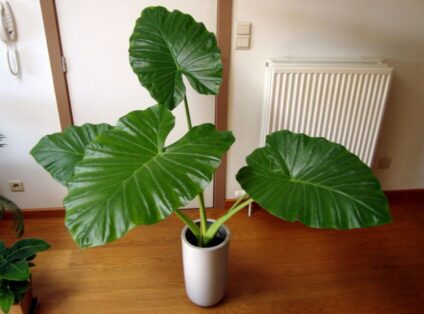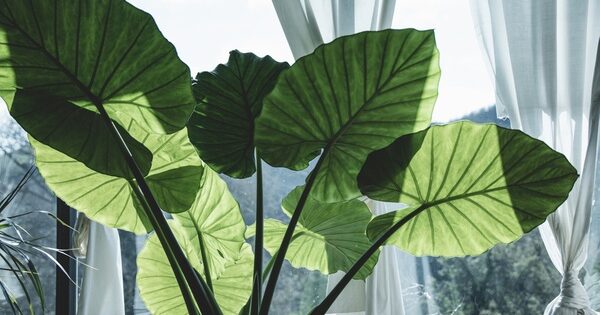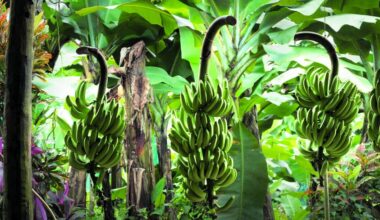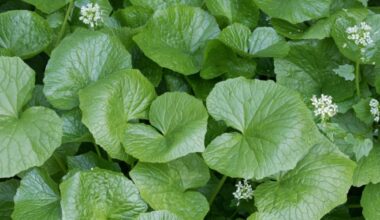Known as Alocasia, the elephant ear is a spectacular green plant. This evergreen perennial is native to tropical forests and warm, humid areas. In France, it is cultivated indoors. The peculiarity of this plant is its large shiny leaves in the shape of elephant ears.
Contents
Ideal soil and exposure for Alocasia planting
The elephant ear can be placed in the shade as well as in full light. Avoid full sunlight, and maintain a temperature between 64 and 71°F.
You can take your potted alocasia out when summer arrives, but always make sure to place it in the shade of larger plants or trees. This proximity will also allow it to maintain its humidity level.
Tuck it in before the first cold spells. A drop in temperature can cause the leaves to fall off, but if your elephant ear has not been exposed to frost, new leaves will appear during the growing season.
Growing alocasia in an apartment is quite tricky, but some species of the genus have been designed to make it easier. This is particularly the case of the alocasia Bambino Arrow, whose compact size easily adapts to small spaces.
How do you take care of an elephant ear plant indoors?
During the growing season between May and October, apply liquid fertilizer at watering time approximately every two weeks. A special green plant fertilizer will do the trick.
Also, don’t forget to clean the leaves with a damp cloth. Dust should not be allowed to accumulate so that the plant can flourish.
In autumn, mulch the foot abundantly to protect the rhizomes from the cold. The plant is not at all rustic. But if the foliage disappears during the cold period, don’t panic: they will come back as soon as spring.
The flowering (in the form of a spike) is not very impressive and the decorative value of the plant lies especially in its superb leaves.
There are all kinds of variety of alocasia like Alocasia sanderiana. It has large sheets of geometrical aspect, with corrugated edges, green metallized with the silvery veins, with the reverse sometimes purple. You will find plants or even bulbs in garden centers. This exotic plant will give a very decorative rendering in the middle of the other house plants.
How often do you water indoor elephant ears?
- During the growing season (May to September), water once or twice a week with a liquid fertilizer every 15 days. The root ball must remain moist but not wet.
- Maintain a constant humidity by placing the pot on a bed of clay balls bathed in a little water.
- In winter, make sure to let the rootball dry between watering (about every 10 days). Spray the foliage often.

Multiply your elephant’s ear
The sowing of seeds in a mini greenhouse heated to 72°F is possible from the beginning of spring. The division of the rhizomes is a simpler method, which can be done in spring.
How to repot the elephant ear?
Replace your elephant ear every spring. Prepare a new humus-free, neutral to acidic and well-drained soil.
Why is my alocasia “crying”?
The leaves of houseplants as well as garden plants can start dripping when there is excess moisture in the air and the plant has just been freshly watered. This excess water creates pressure on the roots and the plant can no longer regulate its water level properly. It will therefore start to drip to reduce the pressure on its roots.
Although guttation is not dangerous for plants, it can nevertheless indicate over-watering.
Diseases, pests and parasites of the elephant ear
Alocasias are an easy prey for dust mites. Clean the dust from its foliage to avoid invasions.
Raised in a greenhouse, it can also be attacked by scale insects. Remove these invaders with a pad soaked in methylated spirits, and rinse the foliage well.
What fertilizer should be used for elephant ear?
During the growing season, between May and September, bring a liquid green plant fertilizer twice a month. Stop all application in autumn-winter, during its resting period.
Some additional tips
The elephant ear is rather easy to grow, if it grows in good conditions. However, a few extra gestures will contribute to its good health.
First, add fertilizer to the water during the growing season (May to October) every two weeks.
Secondly, the large leaves will appreciate being cleaned from time to time; gently wipe the blade with a damp cloth to remove dust.
Finally, during the winter, make sure the plant has enough light; short days are not very pleasant for the plant.
Summary
The elephant ear (Alocasia) comes in different species that are rhizomatous with sometimes tuberous roots. They are persistent perennials native to the tropical forests and humid and hot zones of South and Southeast Asia.
The larger the surface area of the plant’s leaves, the more oxygen they can produce. This makes alocasia, with its enormous leaves, a very large producer of O2 which contributes to a pleasant indoor climate.









